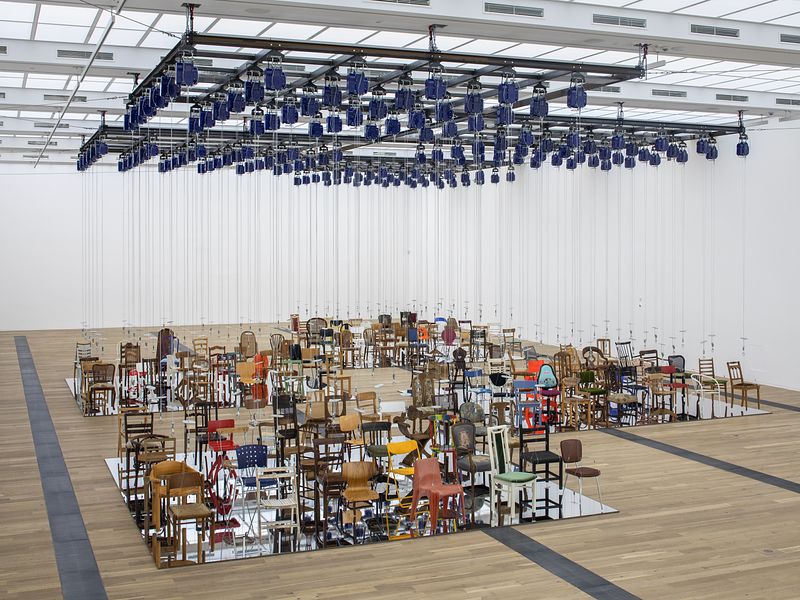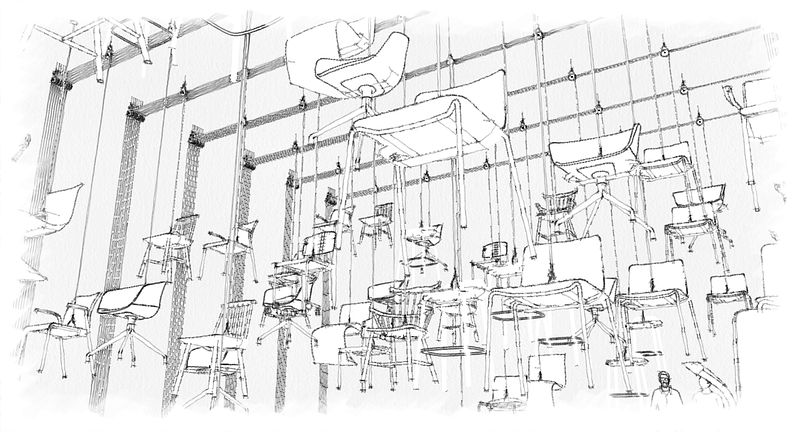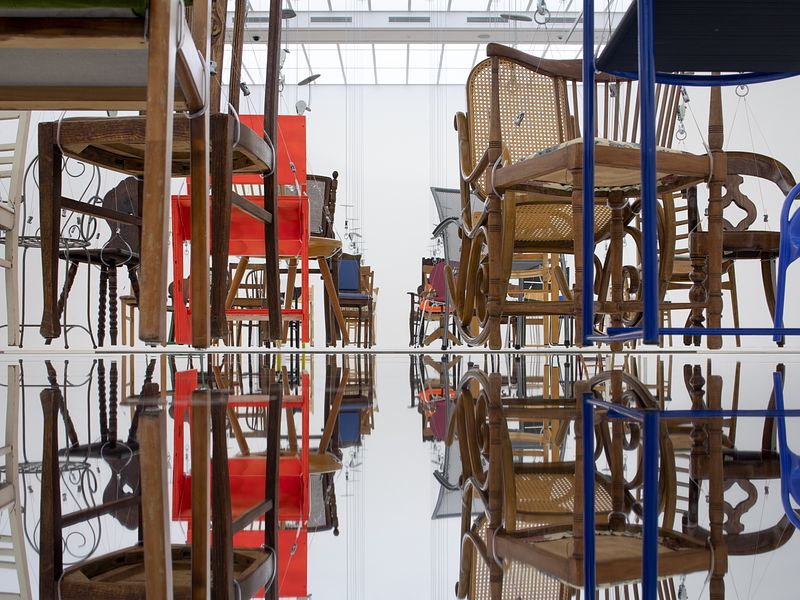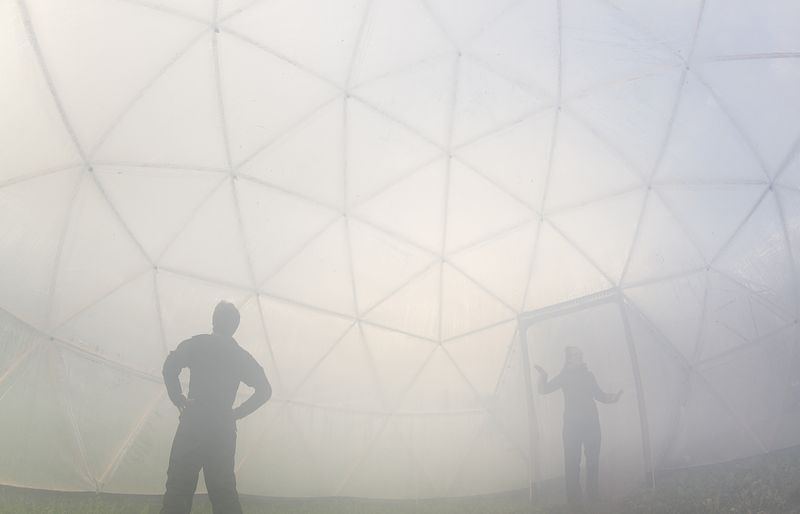01.11.2022
Michael Pinsky, The Final Bid to Save the Planet

Alethea Magazine: Mr Pinsky, I am very curious. Have the first chairs arrived yet and how is the whole thing going?
Michael Pinsky: The museum sent me pictures of chairs and I know they probably have 50 chairs now. It's already a good selection and there are some fun ones.
Hopefully people will want to buy them later.
Alethea Magazine: How many chairs does the artwork need and what stage of the project are you at now?
Michael Pinsky: We need about 160-170 chairs for the artwork, but also a few more because some chairs are not well suited. The museum has advertised online so far - when they go door to door on the street they will probably get more chairs.
The first part of the project will be in mid-September when I go to the museum to choose the chairs. In October we will start the artwork properly. In the run-up, we have done the big technical part of the work with all the drawings and planning.
Next week I'll travel to Cologne to inspect the suspension devices and the winches for pulling up the chairs.
Alethea Magazine: How did you meet the people from the Draiflessen Collection?
Michael Pinsky: Another artist brought my work to their attention; I didn't know them at all. They wanted to work with an artist who was concerned with the environment and climate change. We initially wanted to show my Pollution Pods, but we couldn't because of the very sophisticated fire alarm system in the museum.
So they suggested showing them outside the museum, but then the museum would have been empty inside.
So I had to come up with another idea for inside the museum. "The Final Bid" is new and experimental. Apart from the technical aspects, it's a question of how people will interact with it. How will visitors react to the chairs and will they
eventually buy them?

Alethea Magazine: What is the name "The Final Bid" all about?
Michael Pinsky: In auctions there is "The Final Bid". But the other thing is that we are at the point of ecological collapse if we don't do something incredibly soon and incredibly dramatically. So, it is also the last bid for the planet.
Alethea Magazine: And what role does Draiflessen, as one of the largest clothing retailers in Germany, play in all this?
Michael Pinsky: I am interested in the history of Mettingen. The town's wealth is based on selling things; more than 70 % of the inhabitants were sellers. They came from a peasant culture, travelled in Holland with textiles and lace.
Soon they realised that they made more money doing this than working in the fields.
My artwork is also about the service of selling things. We don't just show something, we also sell it - but in this case nothing new, but something that already exists.


Michael Pinsky, The Final Bid to Save the Planet
A manifesto for the reuse of objects
British artist Michael Pinsky and the Draiflessen Collection, the museum of the C&A family, are looking for chairs for their new exhibition, the installation „The Final Bid“. Alethea Magazine finds out what this action by the environmental artist and activist is all about in this interview. The Final Bid is a world premiere. Michael Pinsky was actually planning to exhibit his world-famous Pollution Pods, an installation where visitors can experience different polluting smells from around the world in different rooms, such as the day-to-day polluting air in central London. Due to the museum's fire alarm system,
this was not possible, which is why the Pollution Pods are now placed outside the museum. For the museum itself, Michael Pinsky has come up with a completely new, experimental project - Mettingen will see a world premiere - and the artist is very excited to see how people will react to it.
For "The Final Bid", chairs are being sought, which will then be used to build a chair installation. The chairs are being sold during the exhibition and then taken away afterwards. The artist refers here to the ecological crisis; the overproduction
and overconsumption of consumer goods. "The Final Bid" is the last bid to save the planet.
In his interview, Michael Pinksy also addresses the history of Mettingen, whose prosperity stems from the tradition of traders. His artwork was also conceived with
trade in mind, and in keeping with the tradition of its founders, something is not only shown, but offered for sale.
C&A confronts overconsumption
It is also a special sign that the Draiflessen Collection Museum is showing this project, given that C&A's history is based on trade, which has its share in the ecological crisis.
this was not possible, which is why the Pollution Pods are now placed outside the museum. For the museum itself, Michael Pinsky has come up with a completely new, experimental project - Mettingen will see a world premiere - and the artist is very excited to see how people will react to it.
For "The Final Bid", chairs are being sought, which will then be used to build a chair installation. The chairs are being sold during the exhibition and then taken away afterwards. The artist refers here to the ecological crisis; the overproduction
and overconsumption of consumer goods. "The Final Bid" is the last bid to save the planet.
In his interview, Michael Pinksy also addresses the history of Mettingen, whose prosperity stems from the tradition of traders. His artwork was also conceived with
trade in mind, and in keeping with the tradition of its founders, something is not only shown, but offered for sale.
C&A confronts overconsumption
It is also a special sign that the Draiflessen Collection Museum is showing this project, given that C&A's history is based on trade, which has its share in the ecological crisis.

Exhibition View Michael Pinksy, THE FINAL BID
| © Draiflessen Collection, Mettingen/Michael Pinsky, Foto/photo: Henning Rogge
Alethea Magazine: Mr Pinsky, I am very curious. Have the first chairs arrived yet and how is the whole thing going?
Michael Pinsky: The museum sent me pictures of chairs and I know they probably have 50 chairs now. It's already a good selection and there are some fun ones.
Hopefully people will want to buy them later.
Alethea Magazine: How many chairs does the artwork need and what stage of the project are you at now?
Michael Pinsky: We need about 160-170 chairs for the artwork, but also a few more because some chairs are not well suited. The museum has advertised online so far - when they go door to door on the street they will probably get more chairs.
The first part of the project will be in mid-September when I go to the museum to choose the chairs. In October we will start the artwork properly. In the run-up, we have done the big technical part of the work with all the drawings and planning.
Next week I'll travel to Cologne to inspect the suspension devices and the winches for pulling up the chairs.
Alethea Magazine: How did you meet the people from the Draiflessen Collection?
Michael Pinsky: Another artist brought my work to their attention; I didn't know them at all. They wanted to work with an artist who was concerned with the environment and climate change. We initially wanted to show my Pollution Pods, but we couldn't because of the very sophisticated fire alarm system in the museum.
So they suggested showing them outside the museum, but then the museum would have been empty inside.
So I had to come up with another idea for inside the museum. "The Final Bid" is new and experimental. Apart from the technical aspects, it's a question of how people will interact with it. How will visitors react to the chairs and will they
eventually buy them?

Michael Pinsky, Concept Sketch (The Final Bid), 2022,
| © Michael Pinsky, Courtesy the artist
The last bid for the planet
Alethea Magazine: What is the name "The Final Bid" all about?
Michael Pinsky: In auctions there is "The Final Bid". But the other thing is that we are at the point of ecological collapse if we don't do something incredibly soon and incredibly dramatically. So, it is also the last bid for the planet.
Alethea Magazine: And what role does Draiflessen, as one of the largest clothing retailers in Germany, play in all this?
Michael Pinsky: I am interested in the history of Mettingen. The town's wealth is based on selling things; more than 70 % of the inhabitants were sellers. They came from a peasant culture, travelled in Holland with textiles and lace.
Soon they realised that they made more money doing this than working in the fields.
My artwork is also about the service of selling things. We don't just show something, we also sell it - but in this case nothing new, but something that already exists.

Installation view THE FINAL BID by Michael Pinsky (2022)
| © Draiflessen Collection, Mettingen/Michael Pinsky, Foto/photo: Henning Rogge
The reuse of objects is very important for our future.
The reuse of objects is very important for our future. We have a culture where we get rid of our old chairs, which end up in a landfill. Then we buy new chairs, as well as computers, phones and kitchens and an increasing turnover of goods that is not sustainable.
Mettingen is an example of a sales culture, and that is what concerns C&A. You have some responsibility in terms of globalisation of goods. You move from things that are bought locally to things that are made on the other side of the world where labour is cheap.
In our time, people buy clothes for a party every other week. That was never the case in our history. The overconsumption of textiles has a huge impact on the environment.
Alethea Magazine: I am also interested in your Pollution Pods. There was also some criticism of this system - how did you solve this technically?
Michael Pinsky: I distilled water with diesel exhaust - the same with plastic, wood and rotten eggs. It was difficult however to keep the right smell strong enough continueously.
If you involve health and safety people, as in the case of Somerset House, you have to have certification, they need paperwork. It's ironic that I couldn't show London air pollution in the middle of London. I met a olfactory historian who writes about smells. She put me in touch with IFF - International Flavour and Fragrances, who have the largest chemical database in the world.
I broke down all the components and they made the smells. At first I used their diffusers, but they weren't tough enough, so I made my own. 99% of London does not meet World Health Organisation (WHO) recommended limits for PM2.5. There are a number of bills that parties are trying to get through at the moment to make the government responsible for clean air.
The German story in this respect is really bad. The German government has invested shares in all the car companies and there has always been an attempt to block any attempt to reduce emissions from engines. That's why the switch to
electric vehicles took 20 years longer than it should have.
Alethea Magazine: I am very much looking forward to The Final Bid. Can I ask how your journey into the arts began?
Michael Pinsky: Right when I left school, I wanted to go to art school. I am also a musician and play the violin. Art is the most flexible of all cultural forms, I make films, installations, prints and all sorts of things. I've always been interested in the environment and I can do anything I want here in art.
Alethea Magazine: Dear Mr. Pinsky, thank you very much for this interview.
Mettingen is an example of a sales culture, and that is what concerns C&A. You have some responsibility in terms of globalisation of goods. You move from things that are bought locally to things that are made on the other side of the world where labour is cheap.
In our time, people buy clothes for a party every other week. That was never the case in our history. The overconsumption of textiles has a huge impact on the environment.
Alethea Magazine: I am also interested in your Pollution Pods. There was also some criticism of this system - how did you solve this technically?
Michael Pinsky: I distilled water with diesel exhaust - the same with plastic, wood and rotten eggs. It was difficult however to keep the right smell strong enough continueously.
If you involve health and safety people, as in the case of Somerset House, you have to have certification, they need paperwork. It's ironic that I couldn't show London air pollution in the middle of London. I met a olfactory historian who writes about smells. She put me in touch with IFF - International Flavour and Fragrances, who have the largest chemical database in the world.
I broke down all the components and they made the smells. At first I used their diffusers, but they weren't tough enough, so I made my own. 99% of London does not meet World Health Organisation (WHO) recommended limits for PM2.5. There are a number of bills that parties are trying to get through at the moment to make the government responsible for clean air.
The German story in this respect is really bad. The German government has invested shares in all the car companies and there has always been an attempt to block any attempt to reduce emissions from engines. That's why the switch to
electric vehicles took 20 years longer than it should have.
Alethea Magazine: I am very much looking forward to The Final Bid. Can I ask how your journey into the arts began?
Michael Pinsky: Right when I left school, I wanted to go to art school. I am also a musician and play the violin. Art is the most flexible of all cultural forms, I make films, installations, prints and all sorts of things. I've always been interested in the environment and I can do anything I want here in art.
Alethea Magazine: Dear Mr. Pinsky, thank you very much for this interview.

Michael Pinsky, Pollution Pods, Norwegen 2017, Courtesy der Künstler
| © Michael Pinsky, Foto/ photo: Thor Nielsen / NTNU
The interview was conducted exclusively by Claudia Mauer for ALETHEA & ART MAGAZINE. It was published online in August.